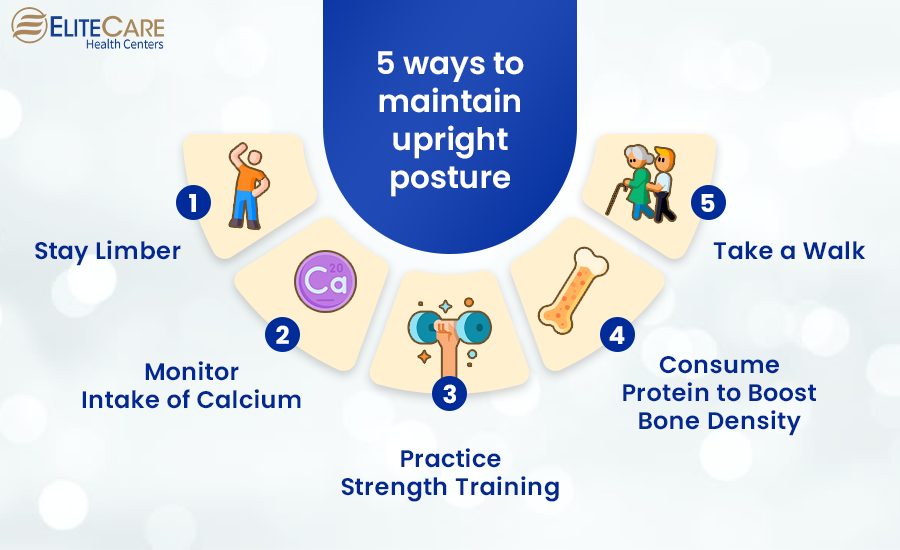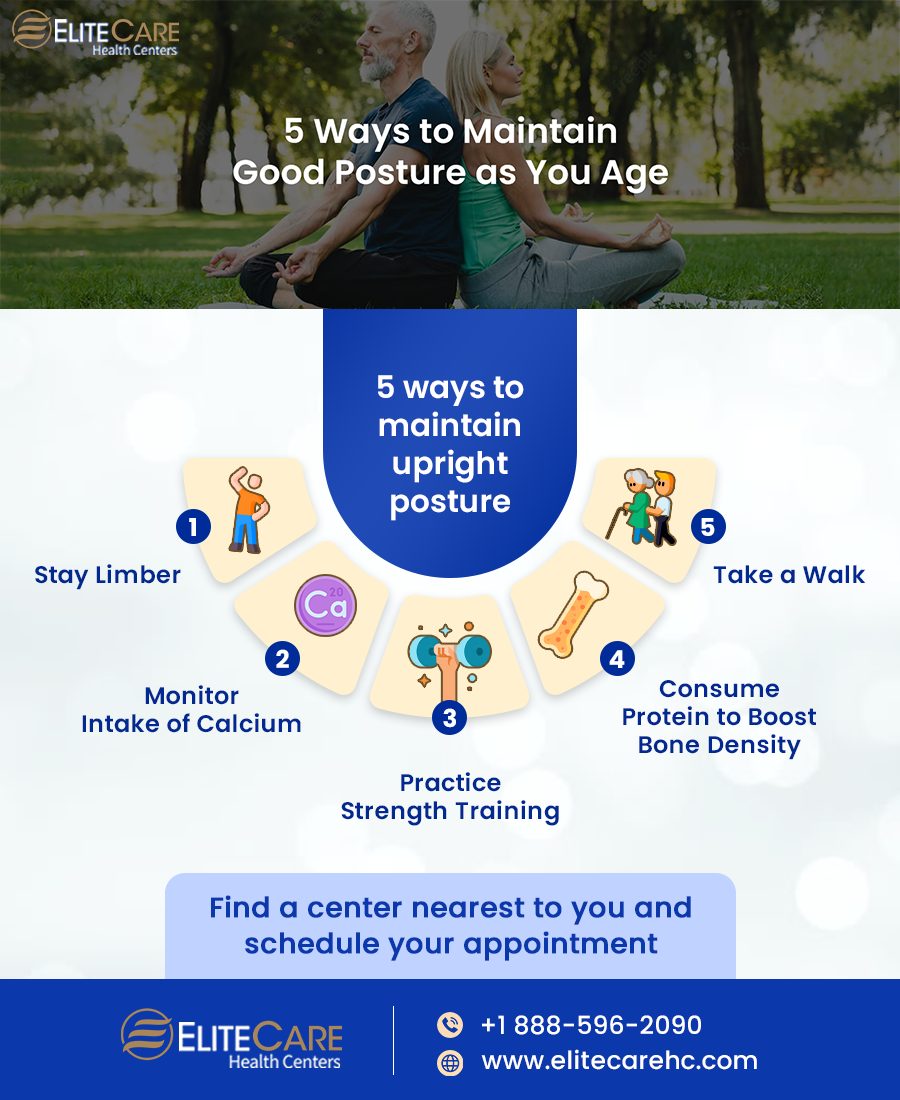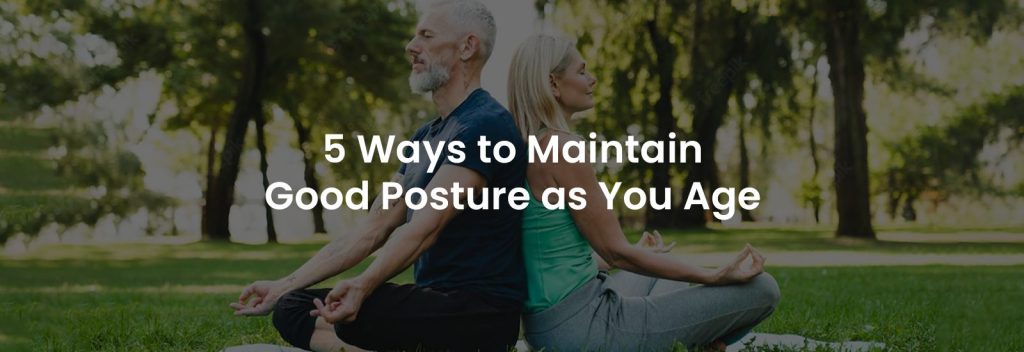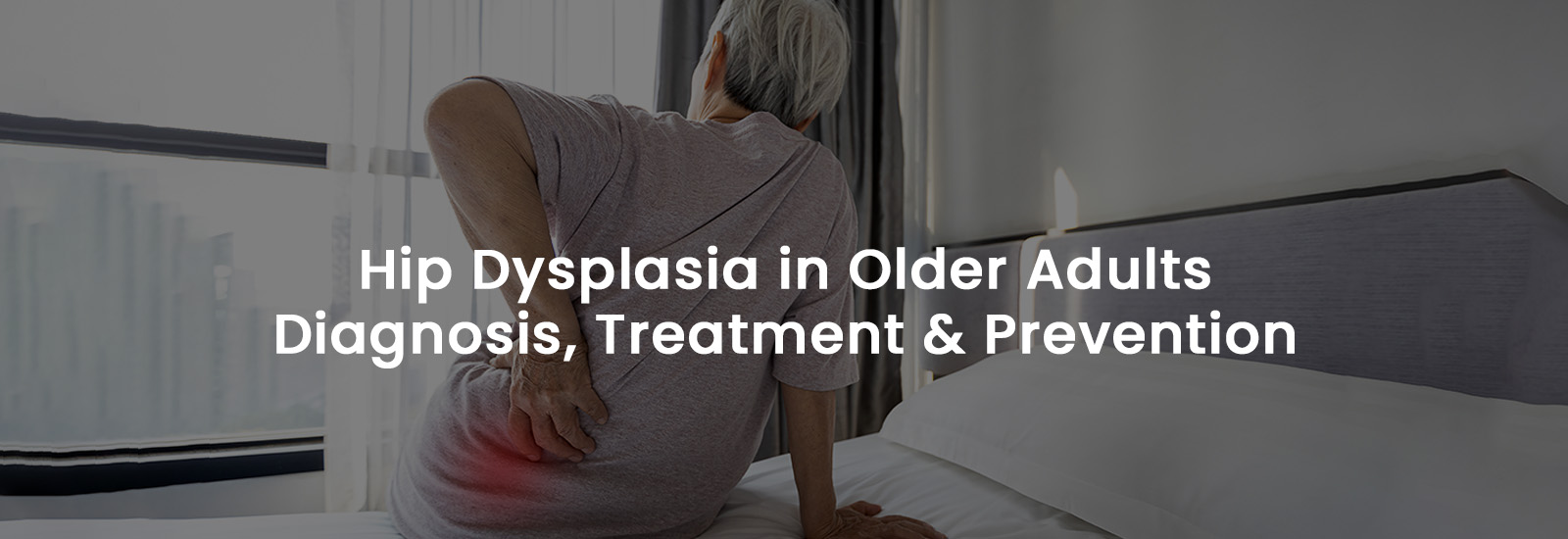
Posture changes associated with aging can cause impaired mobility and increase the risk of falls. There are generally 3 ways posture changes happen in older adults which are as follows:
- Tendency to stoop.
- Loss of height.
- Gait changes and their steps become shorter.
Do you ever wonder why these changes happen? Let’s take a look.
Why does posture change with age?
Aging has a direct effect on three main “systems” that enable good posture.
- Bones: Arthritis, osteoporosis, and osteopenia lead to calcium loss in the body. It makes the column of bones or vertebrae in the spine less dense over time. As a result, these weakened bones can contribute to posture-related problems.
- Discs: As we age, the spinal discs start losing hydration due to lack of spinal fluid that works like a cushion between the bones. The lack of spinal fluid can lead to friction between the bones and results in bone decay.
- Muscles: The muscles support the spine and keep the torso upright. Muscle loss with age is a common issue and affects posture greatly. Regular exercise and a healthy diet can ensure healthy muscle tissues as we age.
Read More: Is Arthritis Preventable in Seniors?
5 ways to maintain upright posture

Although experiencing a change in posture is considered part of the aging process, it can affect the quality of life for seniors. It also increases the risk of fall-related injuries. However, a few healthy activities and habits can help improve age-related posture changes. Here are 5 ways in which seniors can maintain an upright posture.
1. Practice Strength Training
Strength training is the use of resistance to contract muscles in order to increase strength, anaerobic endurance, and skeletal muscle size. It is extremely beneficial for maintaining muscular mass, which is crucial for improving posture. Besides, it also has a direct influence on essential muscles that are required to keep you upright.
In addition, strengthening the shoulder muscles helps with posture correction. Strong shoulder muscles will draw the shoulder blades back and assist in standing in a more upright, raised stance. Seniors can practice strength training by lifting light weights, working with resistance bands, climbing stairs, cycling, etc. However, always consult the trainer or the physician before starting any exercise regime.
2. Increase bone density
Intake of an adequate amount of protein is essential to maintain bone density. Experts recommend that protein consumption amongst older adults must be as per the following formula:
- 0.019 to 0.032 oz of protein per pound of body weight
- For example, if a person weighs 110 pounds, he will require 2.09 to 3.52 oz of protein every day.
There are some foods which work as a natural source for protein. But seniors can also use protein-based supplements after consulting with their doctor. The food items that help in fulfilling the requirement of protein in the body are as follows:
- Eggs, as they are a great source of protein that is also easily absorbed.
- Nuts, especially 6 to 8 almonds per day are recommended.
- Cottage cheese- a rich source of protein, also low in fat and calories.
- Fish- a great source of lean protein, but also provides vitamins, and minerals like iodine, selenium, and vitamin B12.
Read More: Benefits of physical therapy for seniors
3. Monitor Intake of Calcium
Calcium is an essential mineral for numerous bodily activities. It is good for the bones, heart, blood, muscles, and nerves. It is also necessary for maintaining a healthy spine that promotes overall body posture.
The following foods can ensure adequate calcium intake for the elderly.
- Dairy products like Cheese, milk, and yogurt
- Dark green leafy veggies like broccoli and kale
- Fish such as cardines, salmons etc.
- Calcium-fortified meals and beverages like soy products, cereal & fruit juices, and milk
If seniors don’t receive enough calcium over time, they are far more likely to develop osteoporosis, a disorder that affects more than 10 million people in the US over the age of 50.
Read More: A Complete Guide to Managing Osteoporosis in Seniors
4. Take a walk
Weight-bearing exercises such as walking or climbing stairs can also help in retaining strength and avoiding vertebral degeneration that contribute to posture changes. However, it is necessary to keep a proper walking posture in everyday life to avoid stooping and hunch backs.
Here are a few things seniors need to keep in mind while taking a walk.
- Walk straight while holding the head high.
- Avoid slouching, hunching, or leaning forward, since these postures might strain the back muscles.
- Focus on tightening and activating the core muscles with each stride by drawing your belly button in toward your spine.
- Swing the arms back and forth at the sides while walking. Make sure that the arms are swinging from the shoulders, not the elbows.
Knowing how to hold the walking posture correctly keeps the bones and joints straight. It also reduces joint, muscle, and ligament wear and strain.
5. Stay limber
People who spend most of their time at a desk or in front of a computer require a good range of motion in between the activities Take a few minutes of break after every hour to stretch the arms overhead with the fingers interlaced. Walking around also helps as a motion exercise. There are simple exercises seniors can do to stay limber.
- Static stretching: It is stretching with the purpose of releasing a muscle by maintaining a position for 30 – 60 seconds with minimal effort.
- Dynamic stretching: It consists of stretching the muscle with repetitive movement of certain body areas such as the neck, shoulders, and upper back, triceps, sitting hip stretch, etc. To combat the age-related postural changes, it is necessary to include regular stretching practice with a heavy emphasis on posture in your everyday life.
Read More: Tips to Prevent Herniated Disc
Takeaway
Maintaining excellent posture promotes better body balance and reduces your risk of postural deformities. Contact our EliteCare team of health and wellness specialists for individualized advice on nutrition and exercises to maintain healthy body posture.






